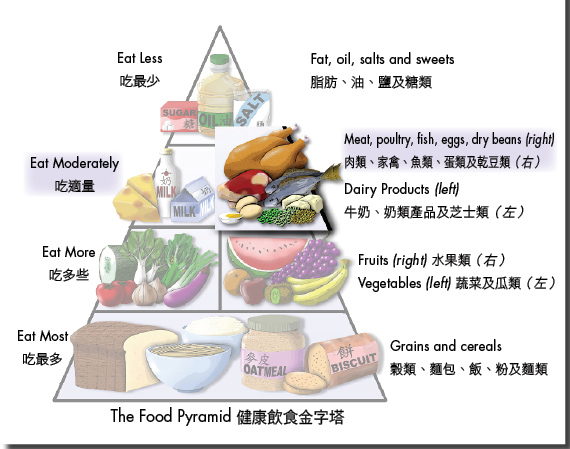
Food Safety Focus (29th Issue, December 2008) – Food Safety Platform
Nutrient and Health - Energy and Protein
Reported by Ms. Jacqueline FUNG, Scientific Officer,
Risk Communication Section,
Centre for Food Safety
Starting from this issue, the nutrition series will focus on selected nutrients. To begin with, we introduce the power that keeps us moving (i.e. energy) and the substance that helps us growing (i.e. protein).
Energy
If the body is a machine, then food is the fuel. Being more specific, carbohydrates, fat and protein in foods provide energy for body functions and physical activities (see table 1). They, however, do not produce the same amount of energy (see table 2). Fat produces more than two times energy per gram than either carbohydrates or protein. Metabolism in the body converts carbohydrates, protein and fat into energy. Any excess of these nutrients will be stored as fat in the body. In other words, regardless of whether it is carbohydrates, protein or fat, it will be converted into fat storage in the body if it is not used. As our body fat accumulates, our body weight increases.
Table 1
World Health Organization's Population Nutrient Intake Goals on Energy-producing Nutrients
- Carbohydrates = 55-75% of energy contribution
- Protein = 10-15% of energy contribution
- Fat = 15-30% of energy contribution
Table 2
Energy Content of Nutrients : -
- 1 gram of carbohydrates = 4 kilocalories
- 1 gram of protein = 4 kilocalories
- 1 gram of fat = 9 kilocalories
- In addition to carbohydrates, protein and fat, alcohol can also provide energy (1 gram alcohol = 7 kilocalories)
Note : -
- Kilocalorie (kcal) and kilojoule (kJ) are measuring units for energy.
- 1 kilocalorie is approximately equal to 4.2 kilojoules.
The energy requirements of individuals vary according to several factors, including the thermic effect of food (the energy required to process foods), the basal metabolic rate and the physical activity level. With reference to the Chinese Recommended Nutrient Intake (RNI), the energy requirements for an adult male and female with light physical activities are around 2400 kcal and 2100 kcal per day respectively. For weight maintenance, it is important to balance energy intake and energy used. Therefore, to help control the body weight, one can decrease the energy intake and/or increase physical activities.
Protein
The body uses protein to build and repair all body tissues. Amino acids are the building blocks of protein. There are nine essential amino acids (see table 3), which the body cannot make or cannot make enough to meet the needs. Therefore, they are essential components of our diet. Generally, protein from the animal source is considered as complete protein since it contains all the essential amino acids, whereas protein from the plant source, except soy protein, is limiting in one or more essential amino acids. For example, grains are limited in lysine and legumes are limited in methionine, two of the nine essential amino acids. For strict vegetarians, it is recommended that their diet should include a mix of foods from various plant sources, so that different foods complement each other (i.e. the essential amino acid missing from one source is supplied by another), making a meatless diet to be one with all the essential amino acids.
Table 3
| Nine Essential Amino Acids | ||
|---|---|---|
| Histidine | Lysine | Threonine |
| Isoleucine | Methionine | Tryptophan |
| Leucine | Phenylalanine | Valine |
Protein deficiency is not common in Hong Kong . However, Protein-energy Malnutrition (PEM) is one of the world's most widespread malnutrition problems, which is prevalent in Africa . At the other end, excess intake of protein offers no extra health benefits as additional protein that is not used by the body will be converted to fat. During the conversion, protein is being broken down and excess nitrogen is being excreted, thereby putting extra stress on the liver and kidneys. This is a particular concern for individuals with kidney diseases. Thus, patients with kidney disease are often advised to consume a diet with protein that is of good quality, but in limited quantity.
According to the Chinese Recommended Nutrient Intake (RNI), an adult male and female with light physical activity levels should consume 75 g and 65 g of protein per day respectively. Children, teenagers, pregnant and lactating women need more proteins for growth.
Meat, poultry, fish, eggs and dry beans are good sources of protein. With reference to the Food Pyramid, it is the third-level up under the "Eat Moderately" level. In terms of actual amount, an adult should eat 5-6 taels (equivalent to 200-240 g) of meat a day.
llustration: Food Pyramid

In the next issue, we will examine another macronutrient – Carbohydrates: the body's preferred energy source.


